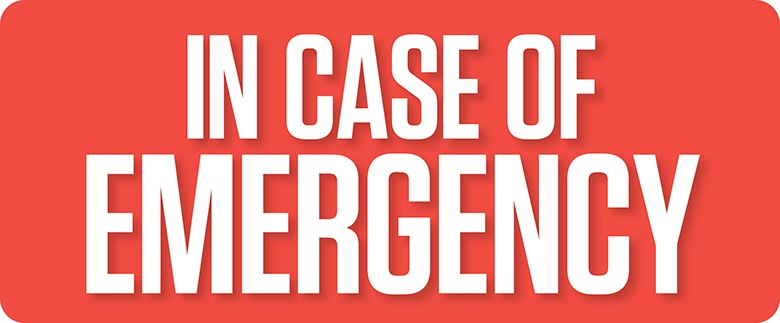
No one wants to break the glass, or reach for the red book, or the red files, or whatever system you use (hoping you have a system) to identify the procedures to follow in the event of an emergency. As we have seen dozens of times since the start of school, having systems and procedures in place to respond to those incidents is imperative because the incidents are increasing along with the scope of the possible incidents. The central role of transportation in both access and egress to event sites makes it more imperative that we have fully defined what we expect of all our team members when these events occur.
What is an Emergency?
One of the major challenges with developing an emergency response plan is the lack of definition as to what constitutes an emergency. The eye of the beholder cannot be the standard when putting together the strategies, tactics, and activities necessary to respond to an incident. The consequence of this observation is that one of the first tasks of any transportation leader is to coordinate with their district counterparts to define the types of events and incidents that will demand the activation of an emergency response plan. The nature of these discussions must address:
• The type and scope of an event that triggers emergency procedures.
• The command-and-control structure that will dictate the management of the event response.
• The reporting and response requirements within the structure that recognizes both the internal and external stakeholder needs.
• The data collection and analysis processes that identify when conditions are inconsistent with original assumptions and require a revision of approach.
The Department of Homeland Security and the Federal Emergency Management Agency (FEMA) have developed a broad range of resources on creating and developing an incident command system (FEMA – Emergency Management Institute (EMI) Course | IS-100.C: Introduction to the Incident Command System, ICS 100). The structure and approaches detailed in the documentation and training that is made available are designed to create continuity in the response and promote effective implementation of defined procedures. While transportation managers may not be primarily responsible for the development of these plans, it is important to be aware of these resources and approaches. Additionally, in districts or communities where designated resources are not available to lead these efforts, transportation managers can greatly enhance their response capability by studying these practices.
What Do We Need to Prepare For?
School transporters have been experiencing an increased number and a broader range of threats to students and schools. However, the industry has often focused on a fairly narrow range of possible events and responses. As a consequence, the need to develop the administrative, technical, managerial, and leadership skills necessary to respond have become a more important challenge for managers from all districts.
Preparing for and responding to an emergency requires managers to expand their use of processes and technologies to identify threats and develop a response. One key organizational skill to focus on developing is operational risk assessment and response techniques. The basic outline of the assessment approach is designed to create a regular feedback and assessment loop to refresh the potential threats to consider and refine the responses to each individual event.

Zonar has presented on emergency preparedness and provided both examples and case studies that can support transportation leaders as they develop their response processes. A brief read of the industry or regular news gives us plenty of potential events to consider. School lockdowns, parents entering the bus, abductions, school shootings, flooding, and on and on and on are the easy ones to identify. Once we go beyond these, there are a significant number of professional resources to support the identification of possible threats. This resource from the United States Secret Service is a very useful resource for transportation managers.
How Do We Execute on a Response?
One of the key challenges of emergency response, once we have defined what an emergency is, is that the events are emergent. Seems obvious, but emergent isn’t the same as urgent and often response plans unnecessarily and problematically conflate those two things. This implies that we should define further when an emergent event (something that is happening with evolving circumstances) requires an urgent (immediate) versus a measured response. The best example for transportation managers might be weather events. It is possible to have weather emergencies that give us days to prepare (hurricanes) versus weather events that require us to respond right now (tornadoes).
A key discipline transportation managers must develop the ability to discern urgent versus non-urgent response requirements. The key rationale for developing this skill is that every response will require an allocation of scarce resources in the most effective manner possible. How transportation managers decide to dedicate buses, drivers, maintenance technicians, administrative resources, and technical resources is a prime indicator of the likelihood of implementing a successful response.
The development of the actions necessary to respond to an event is the key procedural effort that transportation managers must focus on. The basics of the activities that need to be defined are:
• Who will perform the specific activities required of the response?
• What will those specific activities be?
• Why are we performing the activities in order to establish the intent of the response?
• How are all the activities related and how will the individuals and groups communicate with each other?
• When will each activity start, end, be reevaluated, and be changed?
• Where will each individual and group perform their activities from?
The challenging and time-consuming aspect of this effort is that each of these questions is folded together like a bowl of spaghetti and addressing one means you must address many. Transportation leaders must ensure they properly focus their time and effort to do this well.

What is the Role of Technology in Emergency Planning and Response?
Given the complexity and complications associated with developing an emergency response strategy, deploying technology to support plan development and execution is critical. The goals of the technology deployment should be to:
• Increase the completeness and accuracy of information used in decision-making and response.
• Reduce the time from event occurrence to response reaction.
• Improve the ability to respond to internal and external stakeholders.
• Support the development of options and alternatives to the circumstances of an event.
• Reduce uncertainty before, during, and after the event.
Zonar has previously released a white paper on emergency preparedness that helps define the range of technologies that can be used by school transportation professionals. Defining what data and information is needed for each type of event is an important element in the planning process. Capturing location data (e.g., of the incident, of equipment involved or available nearby, of other resources that may be useful or impactful) is an important starting point. Recognizing both the geographic and temporal aspects of an event, the equipment involved, and the subjects involved can be drawn from key systems including routing software, telematics software, and camera technologies. Finally, one often overlooked and incredibly important data set is the contact database for both internal and external stakeholders.
Be Confident When You Break Glass
No one wants to have to respond to an emergency, but the reality is that it is more likely than not transportation leaders will have to at some point in their career. The ability to confidently respond requires a combination of preparation, technology integration, and training. Using a disciplined process to define the scope of potential incidents, response procedures, communications, and feedback/assessment loops will enhance the ability of an operation to effectively respond when stress levels and consequences are highest.
Tim Ammon serves as vice president & general manager of passenger services for Zonar Systems. With more than 20 years of experience in school transportation operations analysis, Ammon has expertise in student safety protocols, cost management, organizational design, and technology use. Visit www.zonarsystems.com for more information.


